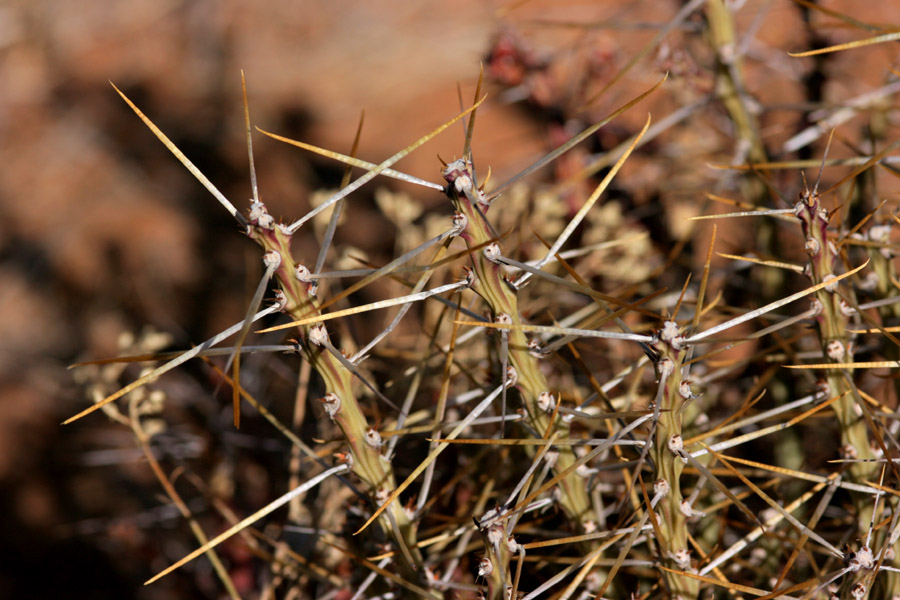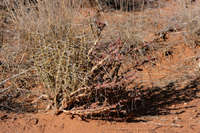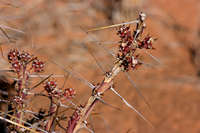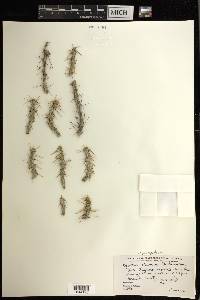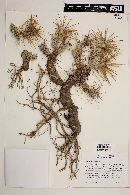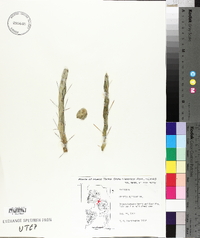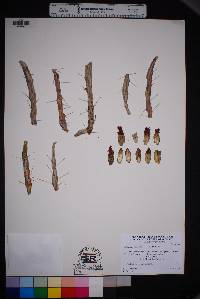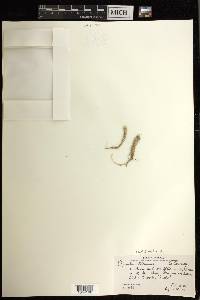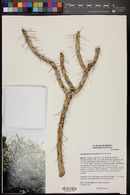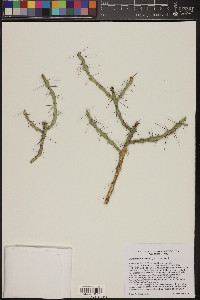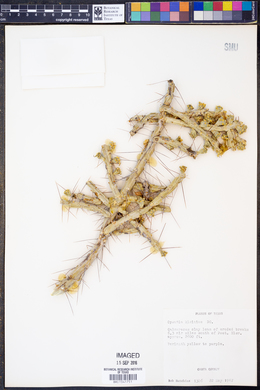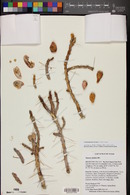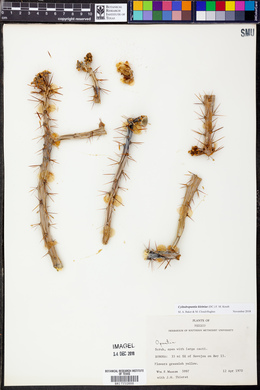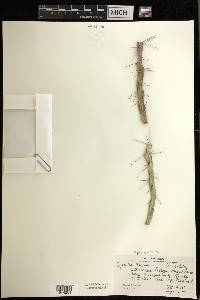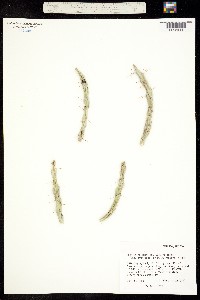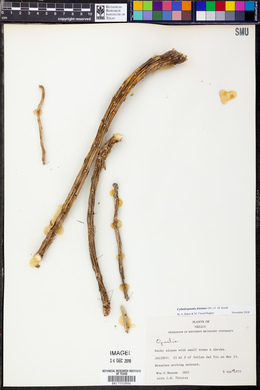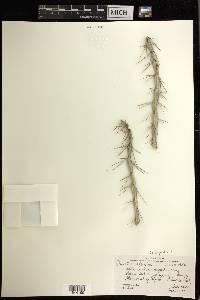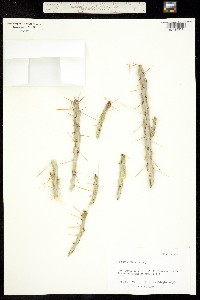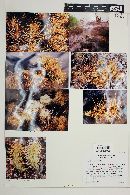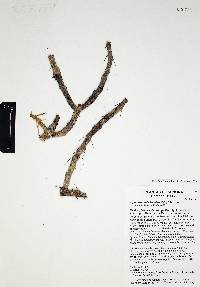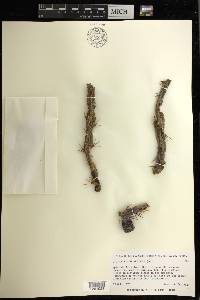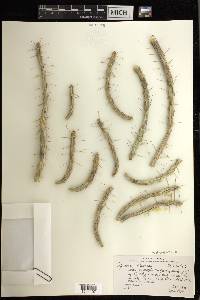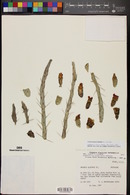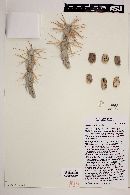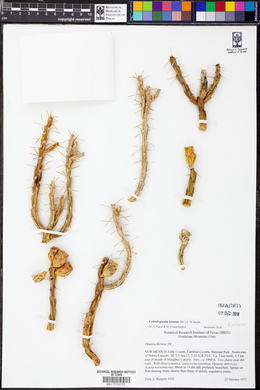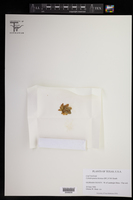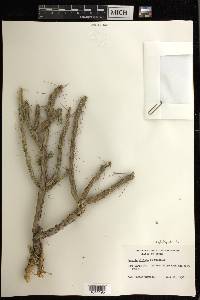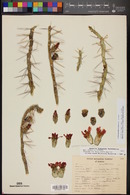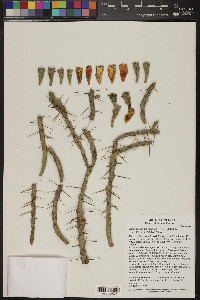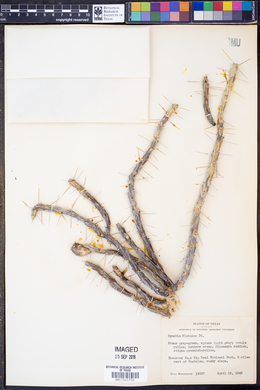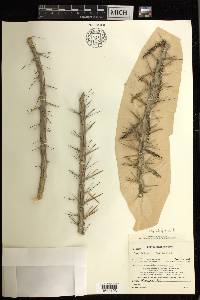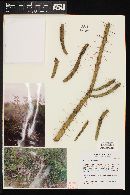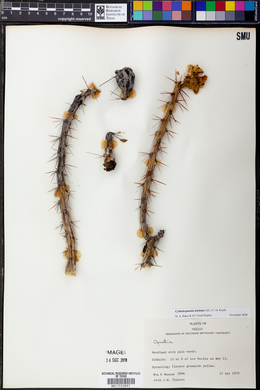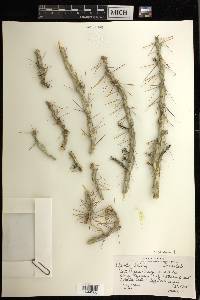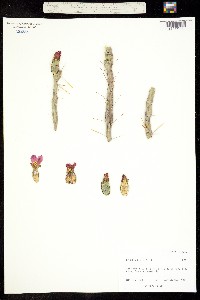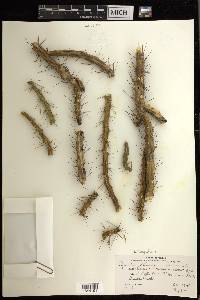
|
|
|
|
Family: Cactaceae
Candle Cholla
[Cylindropuntia recondita (Griffiths) F.M. Knuth, moreOpuntia perrita , Opuntia recondita Griffiths, Opuntia wrightii Engelm.] |
Shrubs scraggly, openly branched, 0.5-2.5 m. Stem segments usually alternate, green, 4-20 × 0.6-1.2 cm; tubercles obvious, 1-2.5 cm; areoles subcircular to oval, 2.5-3.5 × 2-3 mm; wool yellow, aging gray to black. Spines (0-)1-2(-4) per areole, at most areoles, straight to slightly arched, commonly deflexed, not obscuring stem, yellow to gray, tipped yellow, acicular, the longest 1-3 cm. Glochids in adaxial tuft, yellow, 0.5-2.5 mm. Flowers: inner tepals greenish basally to reddish bronze, tinged magenta apically, spatulate-apiculate, 15-25 mm; filaments greenish basally to bronze distally; anthers yellow; style greenish bronze; stigma lobes cream. Fruits green becoming red, obovoid to cylindric, 13-34 × 10-20 mm, fleshy, low tuberculate to smooth, spineless; tubercles subequal; umbilicus 3-6 mm deep; areoles 16-28. Seeds tan, squarish to oval, 4-5 × 3.5-4 mm, warped, sides smooth to lumpy; girdle broad, low-ridged. 2n = 44. Flowering late spring-early summer (May-Jun). Chihuahuan Desert, creosote bush-mesquite flats, limestone rocky slopes; 800-1800 m; N.Mex., Tex.; Mexico (Chihuahua, Coahuila, Durango, Nuevo León). In western Texas and northern Mexico, Cylindropuntia kleiniae forms hybrids with C. leptocaulis (= C. ×antoniae P. V. Heath) that have varying degrees of morphologic intermediacy and chromosome number of 2n = 33. In northern Mexico, C. kleiniae hybridizes with C. imbricata var. imbricata. Cylindropuntia kleiniae itself may be of hybrid origin.
Pinkava 1999, FNA 2003, Benson 1982, Benson 1974 Common Name: candle cholla Duration: Perennial Protected Status: No status in Arizona. General: Shrubs scraggly and openly branched, 0.5-2 m tall, the stem segments usually alternate but branching divergently. The stems green but sometimes with a purplish-red cast, these 10-30 cm long with obvious and prominent tubercles 12-25 mm long and 3-4.5 mm broad by about 3 mm high. The areoles subcircular to oval, 2.5-3.5 mm by 2-3 mm with wool yellow that ages gray to black. Spines: The spines distributed uniformly on joint with 1-4 per most areoles, these straight to slightly arched but mostly tending downward and not obscuring stem, yellow to gray, tipped with yellow, 2-3 cm long and slender but broadly elliptic in cross section, the spines are markedly barbed, the sheaths tan and of much greater diameter than spines making them loose, they are early deciduous and the glochids are yellow. Flowers: Flower 3-5 cm diameter with the inner tepals greenish basally to reddish bronze to purple, they are also tinged magenta near the tip, wedge shaped to obovate, 12-20 mm long by 6-9 mm broad, the filaments greenish basally to bronze distally with yellow anthers, a greenish bronze style and stigma lobes that are cream. Fruits: Fruits green but becoming red, they are obovoid to cylindric and 1.5-2 cm long by 1.2-1.5 cm wide, fleshy at maturity but only slightly juicy, often low tuberculate to smooth and spineless. The tubercles are subequal with 16-28 areoles, a shallow apical Ecology: Found on flats, limestone flats, hills, and along washes in the desert or grasslands from 2,000-4,500 ft (610-1372 m), flowers May-June. Notes: Not listed as being found in Arizona according to USDA Plants DB, designated as being in western Texas and northern Mexico,-Cylindropuntia kleiniae-forms hybrids with-C. leptocaulis-(=-C.-_antoniae-P. V. Heath) that have varying degrees of morphologic intermediacy and chromosome number of 2n-= 33. In northern Mexico,-C. kleiniae-hybridizes with C. imbricata var. imbricata, while Cylindropuntia kleiniae itself may be of hybrid origin. (FNA 2003) Ethnobotany: Unknown Etymology: Cylindropuntia is from Greek kylindros or a cylinder, plus the genus Opuntia, while kleiniae is possibly named for William Klein an American botanist of unknown details. Synonyms: Opuntia kleiniae Editor: LCrumbacher, 2010 |
This project was made possible in part by the Institute of Museum and Library Services [MG-70-19-0057-19].
Powered by Symbiota

